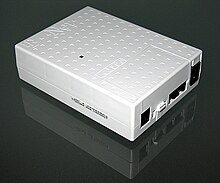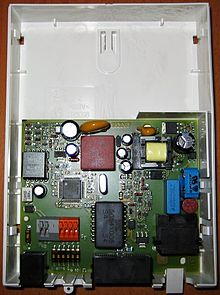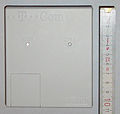Network Termination for ISDN Basic Rate Access
A N etwork T ermination for ISDN B asic rate A ccess ( NT ) is the network termination unit at an ISDN - basic access . In the Deutsche Telekom NT stands also as an abbreviation for N etwork T ermination B asis a nschlus s or N etwork t erminator B asis a onnection .
Features and functions
The NTBA is installed at the telephone subscriber and is usually connected directly to the subscriber line (TAL), i.e. to the first TAE socket or, if available, to the output of a broadband connection unit (DSL splitter). It enables different ISDN-compatible terminal devices to be connected to an ISDN exchange in the public telephone network . NTBAs are required both on a basic connection of the "National ISDN" in Germany ( FTZ 1 TR 6 ) and on the "Euro ISDN connection" ( Digital Subscriber System No. 1 ).
The NTBA forms the transition from the two-wire U K0 interface to the four-wire S 0 bus . This implementation is implemented electronically via a hybrid circuit and with echo compensation .
Furthermore, the NTBA is used for code conversion from MMS43 to AMI code . The goal is the DC voltage-free transmission.
development
1st generation NTBAs were equipped with a transformer power supply . During the 2nd generation, the switch to switched-mode power supply technology took place .
Tensions
See also article ISDN, section control power supply
The NTBA is supplied with a supply voltage of 96 volts from the exchange via the U K0 interface according to the principle of remote feeding, and limited to 60 volts depending on the distance to the exchange. By measuring the open-circuit voltage on the subscriber line, you can check whether it is an ISDN connection. When the U K0 interface is activated , approx. 96 V can be measured (in some cases, e.g. with an optical connection line , 48 to 55 volts are also possible). In contrast, analog connections are only operated with a supply voltage of 60 V.
Up to four devices connected to the S 0 bus without their own power supply are supplied with 40 volts via the power pack contained in the NTBA (power output max. 4.5 W, in emergency mode max. 0.4 W).
Emergency operation
See also article ISDN, section emergency power supply
If the NTBA is not connected to the mains (230 volts), the S 0 supply voltage is generated from the U K0 interface. To signal this fact, the polarity of the S 0 supply voltage changes. Twelve sockets and eight devices can be connected to an NTBA without a power supply, but at least four of these devices require their own power supply.
Devices without their own power supply:
- Telephones with emergency power supply recognize the change in polarity and then work in (mostly functionally restricted) emergency mode.
- Telephones that are not authorized for emergency power supply no longer work, but can remain connected to the bus.
Devices with their own power supply (e.g. telephone systems , ISDN cards in the PC, ISDN telephones with their own power supply unit) can be used despite emergency operation. If such devices are used exclusively, there is no need to connect the NTBA to the power supply.
literature
- Hartmut Ernst, Jochen Schmidt, Gerd Beneken: Basic course in computer science. 6th edition, Springer Fachmedien, Wiesbaden 2016, ISBN 978-3-658-14633-7 .
- Hubert Zitt: ISDN & DSL for PC and telephone. Verlag Markt + Technik, Munich 2005, ISBN 3-8272-6987-3 .
- Peter Bocker: ISDN The service-integrated digital communication network. Springer Verlag, Berlin, Heidelberg 1987, ISBN 3-662-08032-X .





